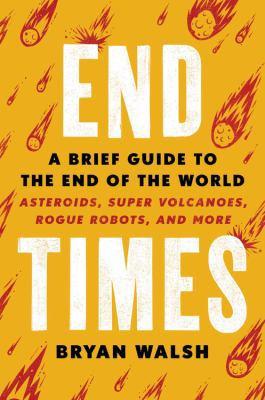
End times : a brief guide to the end of the world : asteroids, supervolcanoes, rogue robots, and more
In End Times, Walsh examines threats that emerge from nature and those of our own making: asteroids, supervolcanoes, nuclear war, climate change, disease pandemics, biotechnology, artificial intelligence, and extraterrestrial intelligence. Walsh details the true probability of these world-ending catastrophes, the impact on our lives were they to happen, and the best strategies for saving ourselves, all pulled from his rigorous and deeply thoughtful reporting and research.
Available Copies by Location
| Location | |
|---|---|
| Victoria | Available |
Browse Related Items
- ISBN: 9780316449618
- Physical Description 406 pages ; 24 cm
- Edition First edition.
- Publisher [Place of publication not identified] : [publisher not identified], 2019.
Content descriptions
| Bibliography, etc. Note: | Includes bibliographical references and index. |
Additional Information

Publishers Weekly Review
End Times : A Brief Guide to the End of the World
Publishers Weekly
(c) Copyright PWxyz, LLC. All rights reserved
Journalist Walsh tries to "wake people up... to the reality of existential threats" that include asteroids, artificial intelligence, and more in this well-intentioned but unsatisfying assessment of risk and prevention. Readers craving gloom and doom will feel especially let down, as Walsh doesn't revel in sensationalistic pessimism. He interviews biologists, climatologists, anthropologists, geologists, astronomers, and even a moral philosopher to grapple with a tough subject: human extinction. He goes into great detail about the ins and outs of tracking near-Earth objects, like the small asteroid that exploded above Chelyabinsk Oblast in 2013, injuring residents, damaging buildings, and catching NASA skywatchers by surprise. He takes the same approach to evaluating "supervolcanoes," such as Toba in Sumatra and Yellowstone in the United States, describing the "guesswork" involved in predicting immense-scale eruptions. Other potential forces of mass destruction discussed are artificial intelligence and biotechnology, particularly the ability to synthesize DNA; both he calls "dual-use technologies," which might either benefit humankind or cause mass suffering, even extinction. Though he succeeds in providing an introduction to how these and other megathreats, readers will be disappointed that Walsh's study offers very few clear answers, and only a vague "existential hope" that solutions can be found. Agent: Todd Shuster, Aevitas Creative. (Sept.)

Kirkus Review
End Times : A Brief Guide to the End of the World
Kirkus Reviews
Copyright (c) Kirkus Reviews, used with permission.
A fascinating and frightening exploration of how "the very future is in danger, as it has never been before, both from an array of cosmic and earthbound threats and from the very technologies that have helped make us so prosperous."Today, assessing the risk of human extinctionand preparing to react to existential threatshas become a science the world can't afford to ignore. For generations, writes Time reporter and editor Walsh, the idea of a single event threatening to end mankind has dominated the box office: "The bloodier and more dystopic, it seems, the more we love itas long as we're watching, and not participating." But are we taking the underlying reality that seeds these ideas seriously? In this unflinching and insightful book, the author delivers all of the gritty details about the most likely end-times events, often contextualizing modern-day threats with historical catastrophes, somber reminders that the vast majority of Earth's species are extinct and that humans are unlikely to be an exception. While human ingenuity has resulted in technologies that may predict and prevent a world-ending natural disaster, advances such as nuclear weapons or synthetic biology have the potential to do irreparable harm if they fall into the wrong hands. Not to mention the threat of climate change, which may end humanity over a period of many years, or a supervirus, which could do the job in just a few months. And yet, the author argues, people are generally unable to accept that nothing about the future is guaranteeda psychological blind spot that may be our undoing. Luckily, there is a cadre of brilliant scientists working on the cutting edge of preventing catastrophe, and Walsh delves deep into their mindsets and research. An engaging writer, the author is most compelling when he outlines "how our species can survive the unsurvivable" through planning, perseverance, and an unshakable desire to carry on.A disturbing, riveting, and ultimately hopeful call to arms. Copyright Kirkus Reviews, used with permission.


